OLYMPIA—For tens of thousands of commuters who take the I-405 and SR-167, expect to pay 33-67% more in toll rates for your daily commute starting March 1. On January 29, 2024, in a Special Meeting, the Washington State Transportation Commission adopted the proposed Phase 1 toll rate adjustments for the I-405 Express Toll Lanes (ETLs) and SR 167 High Occupancy Toll (HOT) Lanes that take effect this Friday.

The reason for the rate increase is that too many commuters using the toll lanes. Deputy Director Carl See shared during the meeting that increased traffic congestion impacted performance goals resulting in decrease funding for improvements to recently awarded corridor projects. The travel times in the general purpose (free) lanes have increased by 3-9 minutes which is three times more than the tolled lanes. The goal is to push more commuters out of the toll lanes into the general purpose lanes to reduce travel time in these lanes. This would further increase travel time for general commuters and incentivize commuters to use mass transit.
The rate increase is the first for the Commission in almost 10 years—2008 for SR-167 and 2015 for I-405—and is expected to generate $4.8 million to $8.3 million in additional revenue between March 2024 to June 2025. The toll rate changes outlined below will take effect on March 1, 2024, as follows:
- Increase the minimum toll rate to $1 (up from 75 cents, or 33% increase for I-405, up from 50 cents, or 100% increase on SR-167)
- Increase the maximum toll rate to $15 (up from $10, or 50% increase for I-405, up from $9, or 67% increase on SR-167)
- Extend evening tolling and peak hour HOV policies by one hour, to 8:00 p.m. The lanes will now be free on weekends (I-405 only) and overnight from 8 p.m. to 5 a.m.
In the 2023-2025 Transportation Budget, the Legislature directed the Commission to review toll revenue performance in the corridor and encouraged adjustment of rates, according to Deputy Director See. In 2022, WSDOT reported roughly 125,000 daily commutes (approximately 60,000 vehicles) occur on I-405 and for SR-167 that number increases to 130,000 commutes (approximately 65,000 vehicles).
According to the Commission, for I-405, the increase is expected to impact 71% of all commutes with 4% falling under the maximum tolling rate.
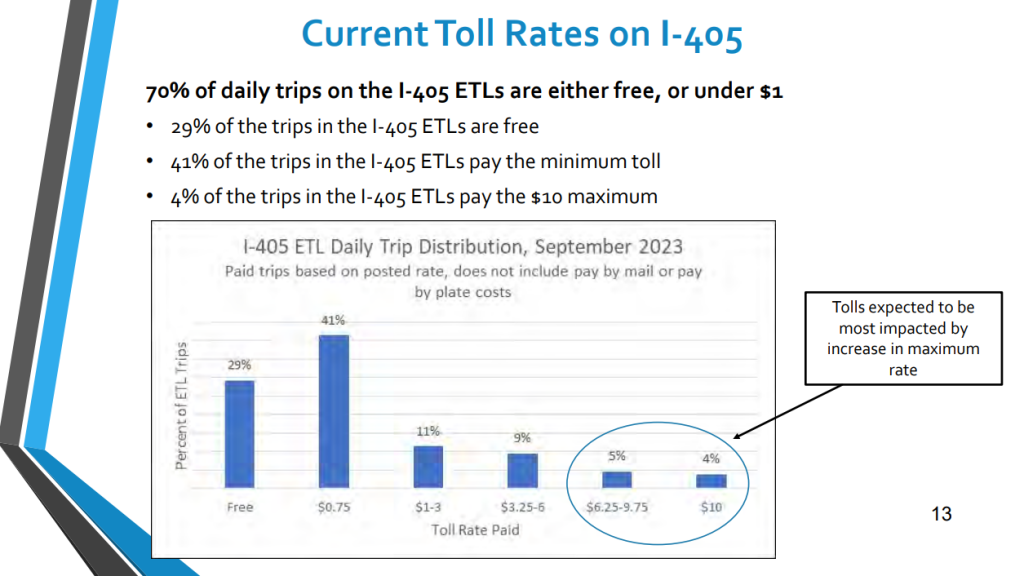
The increase is expected to impact 44% of all commutes on SR-167 with 8% falling under the maximum tolling rate.
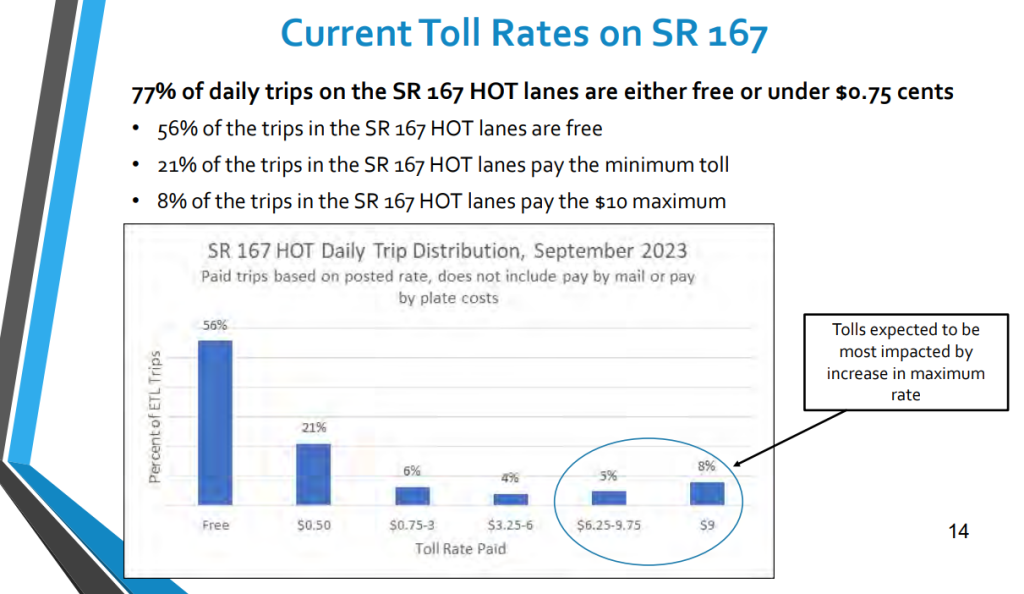
The Commission will be entering the second phase of adjusting toll policies for the entire I-405/SR 167 corridor ahead of the next segment of Express Toll Lanes opening in 2025, as follows:
- Phase 1 – Completed: Adjusted toll rates for the current I-405 ETLs and SR 167 HOT Lanes (see above.)
- Phase 2 (Mid-2024 – Early 2025): Review current toll rates and policies and consider adjustments in advance of the opening of the new Bellevue to Renton ETLs in the summer of 2025, along with upgrading toll equipment on SR 167.
You can find more information on Phase 2 activities here.
The I-405 Express toll lanes (ETLs) located between Bellevue and Lynnwood opened in September 2015, and the SR 167 high occupancy toll (HOT) lanes located between Renton and Auburn opened in May 2008.
Both facilities are dynamically tolled, meaning the price to travel in these lanes varies based on real-time traffic conditions. Toll rates adjust automatically using an algorithm between a minimum and maximum toll rate for each facility.
The amount being charged for using the I-405 ETLs and SR 167 HOT lanes are displayed on the overhead electronic signs. The amount shown on the sign is what you will pay when you enter the lane, even if the toll rate goes up or down after that time. Rates displayed on the sign are by destination/exit.
Toll revenues from the facilities are dedicated to the I-405/SR 167 corridor and may only be used to pay for the facilities’ operating costs, debt service, and to fund projects identified in the corridor’s master plan.

Key Operational Rules
- Tolling and occupancy requirements are in effect only during the hours of operations for each facility.
- Both facilities operate between 5 a.m. – 8 p.m. (as of March 1) Monday – Friday, with SR 167 HOT lanes also in operation during those hours on weekends.
- Carpools with two or more people are exempt from paying a toll on both I-405 ETLs and SR 167 HOT lanes, except during peak periods of 5 a.m. – 9 a.m. and 3 p.m. – 8 p.m. (as of March 1) on I-405 ETLs when only carpools with three or more people are exempt. Motorcycles, transit vehicles, and vanpools will also be exempt.
- Drivers without a Good To Go! account can also use the I-405 express toll lanes and will receive a bill in the mail for their trip. Drivers who chose this option will pay $2 above the posted Good To Go! rate in effect at the time of the trip.
Tolled Lanes Bring Benefits
- Travel time reliability: Proves the choice for a faster and more reliable trip, and supports more reliable transit service.
- Reliably manages congestion in real time: Toll rates adjust based on real-time traffic conditions in support of maintaining an average speed of at least 45 mph in the ETL/HOT lanes.
- Helps fund future congestion relief: Revenues fund current and future improvements to the I-405/SR 167 corridor, in addition to funding operations and maintenance costs for the facilities.
Additional information on each facility can be found at the following links:
EDITOR’S NOTE: Article updated to clarify reason for increasing toll rates. [3:43 pm, 2/25/24]







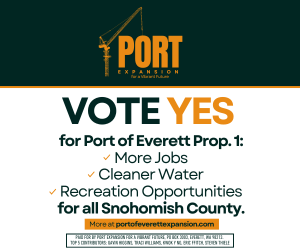
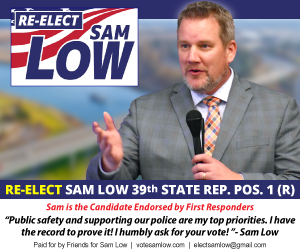





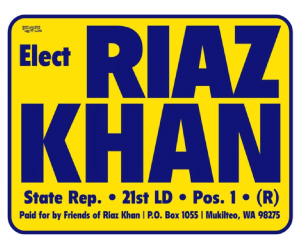





4 Responses
It goes to show ME that people don’t want to pay toles.
The increase rates will impact the lower income people and make their commute time much longer. Perhaps you should go by annual incomes. Or if a person has a disability give them a reduced rate
For some using rapid transit or the bus system is next to impossible for the areas they are going or even trying to find a second person(or more) just is impossible.
Perhaps when signing up to use the toll lanes an application could be used to check certain items – to give these individuals a reduced rate.
I was on disability and now on SS with a very limited income. And any extra savings is so important to me. I get the everyday commuter, but I only use the freeway a couple days a week and it’s mid morning to midafternoon. Maybe give from 9-3 a discount
And if you increase the rates then fix the roads. More potholes everywhere!
Please consider the low income and disabled individuals(who usually are on a lower income)
I thought once the payout was achieved, the toll would go away. That would even out all the lanes and traffic would go smoothly. Jan